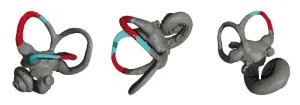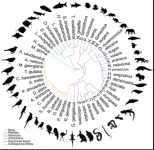(Press-News.org) Humans and our closest relatives, living apes, display a remarkable diversity of types of locomotion—from walking upright on two legs to climbing in trees and walking using all four limbs.
While scientists have long been intrigued by the question of how humans’ bipedal stance and movement evolved from a quadrupedal ancestor, neither past studies nor fossil records have permitted the reconstruction of a clear and definitive history of the early evolutionary stages that led to human bipedalism.
However, a new study, which centers on recently discovered evidence from skulls of a 6-million-year-old fossil ape, Lufengpithecus, offers important clues about the origins of bipedal locomotion courtesy of a novel method: analyzing its bony inner ear region using three-dimensional CT-scanning.
“The semicircular canals, located in the skull between our brains and the external ear, are critical to providing our sense of balance and position when we move, and they provide a fundamental component of our locomotion that most people are probably unaware of,” explains Yinan Zhang, a doctoral student at the Institute of Vertebrate Paleontology and Paleoanthropology of the Chinese Academy of Sciences (IVPP) and the lead author of the paper, which appears in the journal the Innovation. “The size and shape of the semicircular canals correlate with how mammals, including apes and humans, move around their environment. Using modern imaging technologies, we were able to visualize the internal structure of fossil skulls and study the anatomical details of the semicircular canals to reveal how extinct mammals moved.”
“Our study points to a three-step evolution of human bipedalism,” adds Terry Harrison, a New York University anthropologist and one of the paper’s co-authors. “First, the earliest apes moved in the trees in a style that was most similar to aspects of the way that gibbons in Asia do today. Second, the last common ancestor of apes and humans was similar in its locomotor repertoire to Lufengpithecus, using a combination of climbing and clambering, forelimb suspension, arboreal bipedalism, and terrestrial quadrupedalism. It is from this broad ancestral locomotor repertoire that human bipedalism evolved.”
Most studies of the evolution of ape locomotion had focused on comparisons of the bones of the limbs, shoulders, pelvis, and spine and the way they are associated with the different types of locomotor behaviors seen in living apes and humans. However, the diversity of locomotor behaviors in living apes and the incompleteness of the fossil record have hampered the development of a clear picture of human bipedalism’s origins.
The skulls of Lufengpithecus—originally discovered in China’s Yunnan Province in the early 1980s—have given scientists the opportunity to address, in new ways, unanswered questions about the evolution of locomotion. However, the heavy compression and distortion of the skulls obscured the bony ear region and led previous researchers to believe that the delicate semicircular canals were not preserved.
To better explore this region, Zhang, Ni and Harrison, along with other researchers at IVPP and the Yunnan Institute of Cultural Relics and Archaeology (YICRA), used three dimensional scanning technologies to illuminate these portions of the skulls to create a virtual reconstruction of the inner ear’s bony canals. They then compared these scans to those collected from other living and fossil apes and humans from Asia, Europe, and Africa.
“Our analyses show that early apes shared a locomotor repertoire that was ancestral to human bipedalism,” explains IVPP Professor Xijun Ni, who led the project. “It appears that the inner ear provides a unique record of the evolutionary history of ape locomotion that offers an invaluable alternative to the study of the postcranial skeleton.”
“Most fossil apes and their inferred ancestors are intermediate in locomotor mode between gibbons and African apes,” adds Ni. “Later, the human lineage diverged from the great apes with the acquisition of bipedalism, as seen in Australopithecus, an early human relative from Africa.”
By studying the rate of evolutionary change in the bony labyrinth, the international team proposed that climate change may have been an important environmental catalyst in promoting the locomotor diversification of apes and humans.
“Cooler global temperatures, associated with the build up of glacial ice sheets in the northern hemisphere approximately 3.2 million years ago, correspond with an uptick in the rate of change of the bony labyrinth and this may signal a rapid increase in the pace of ape and human locomotor evolution,” explains Harrison.
Images of the reconstruction of locomotor behavior and environment of Lufengpithecus and of reconstructed inner ear of Lufengpithecus are available upon request.
# # #
END
How did humans learn to walk? New evolutionary study offers an earful
The inner ear of a 6-million-year-old fossil ape reveals clues about the evolution of human movement
2024-01-29
ELSE PRESS RELEASES FROM THIS DATE:
Alzheimer’s disease acquired from historic medical treatments
2024-01-29
Five cases of Alzheimer’s disease are believed to have arisen as a result of medical treatments decades earlier, reports a team of UCL and UCLH researchers.
Alzheimer’s disease is caused by the amyloid-beta protein, and is usually a sporadic condition of late adult life, or more rarely an inherited condition that occurs due to a faulty gene. The new Nature Medicine paper provides the first evidence of Alzheimer’s disease in living people that appears to have been medically acquired and due to transmission of the amyloid-beta protein.
The people described in the paper had all been treated as ...
Food insecurity and premature mortality and life expectancy in the us
2024-01-29
About The Study: Although the association of food security and life expectancy varied across sex and racial and ethnic groups, overall, lower levels of food security were associated with a higher risk of premature mortality and a shorter life expectancy in this study of 57,000 adults. The findings of this study highlight the potential importance of improving food security in promoting population health and health equity.
Authors: Lu Qi, M.D., of Tulane University in New Orleans, is the corresponding author.
To access the embargoed ...
Wealth redistribution to extend longevity in the U.S.
2024-01-29
About The Study: The findings of this study of 35,000 adults age 50 or older suggest that wealth inequality in the U.S. is associated with significant inequities in survival. Wealth redistribution policies may substantially reduce those inequities and increase population longevity.
Authors: Kathryn E. W. Himmelstein, M.D., M.S.Ed., of Massachusetts General Hospital in Boston, is the corresponding author.
To access the embargoed study: Visit our For The Media website at this link https://media.jamanetwork.com/
(doi:10.1001/jamainternmed.2023.7975)
Editor’s Note: Please see the article for additional information, including other authors, author contributions and ...
Efficacy of electronic cigarettes vs varenicline and nicotine chewing gum as an aid to stop smoking
2024-01-29
About The Study: In this randomized clinical trial including 1,068 smokers, electronic cigarettes were as effective as varenicline and more effective than nicotine chewing gum as a stop-smoking aid when all three treatments were provided with minimal behavioral support.
Authors: Zhao Liu, Ph.D., of the China-Japan Friendship Hospital in Beijing, is the corresponding author.
To access the embargoed study: Visit our For The Media website at this link https://media.jamanetwork.com/
(doi:10.1001/jamainternmed.2023.7846)
Editor’s Note: Please see the article for additional information, ...
High school students who report using alcohol, cannabis or nicotine at higher risk for suicidal thoughts and other mental health disorders
2024-01-29
BOSTON –High school students who reported using cannabis, alcohol, or nicotine were more likely to have thoughts about suicide, feel depressed or anxious, have unusual experiences, and exhibit inattention or hyperactivity, according to recent survey-based study conducted by researchers at Massachusetts General Hospital (MGH) and the University of Minnesota.
The study, which is published in JAMA Pediatrics, included 2022–2023 survey results from more than 15,000 high school students across Massachusetts.
“We sought to determine ...
New evidence informs risk factors, diagnosis and care of patients with CVT stroke
2024-01-29
Embargoed until 4 a.m. CT/5 a.m. ET Monday, Jan. 29, 2024
DALLAS, January 29, 2024 — A new scientific statement from the American Heart Association emphasizes the need to increase patients’ and physicians’ awareness of cerebral venous thrombosis (CVT) to improve the recognition of this condition and initiate prompt medical treatment. The new statement, Diagnosis and Management of Cerebral Venous Thrombosis, published today in the American Heart Association/American Stroke Association’s peer-reviewed journal Stroke. ...
Researchers map genome for cats, dolphins, birds, and dozens of other animals
2024-01-29
Researchers mapped genetic blueprints for 51 species including cats, dolphins, kangaroos, penguins, sharks, and turtles, a discovery that deepens our understanding of evolution and the links between humans and animals.
“Being able to access that genetic information will have huge implications for understanding human health and evolution,” said lead author Michael Schatz, a Bloomberg Distinguished Professor of computer science and biology at Johns Hopkins University. “A lot of work ...
Overcoming the stigma: study recommends steps to move past barriers of brain health conversation
2024-01-29
INDIANAPOLIS -- Approximately four of five primary care clinicians consider themselves on the front lines of brain health. In the U.S., clinicians are the first point of contact for patients worried about memory loss and are most likely the first to detect and evaluate patients experiencing mild cognitive impairment, Alzheimer’s disease or related dementias.
In a new study focused on understanding the barriers of clinician-patient conversations about brain health and cognitive concerns, Regenstrief Institute and Indiana University School of Medicine Research Scientist Malaz Boustani, M.D., MPH, found that early conversations about brain health between ...
PolyU develops high-efficiency carbon dioxide electroreduction system for reducing carbon footprint and progressing carbon neutrality goals
2024-01-29
Global warming continues to pose a threat to human society and the ecological systems, and carbon dioxide accounts for the largest proportion of the greenhouse gases that dominate climate warming. To combat climate change and move towards the goal of carbon neutrality, researchers from The Hong Kong Polytechnic University (PolyU) have developed a durable, highly selective and energy-efficient carbon dioxide (CO2) electroreduction system that can convert CO2 into ethylene for industrial purposes to provide an effective solution for ...
Lopsided galaxies shed light on the speed of dark matter
2024-01-29
So how can the speed of dark matter be measured? The prerequisite is to find a galaxy in the universe that moves relative to dark matter. Since everything in the universe is in motion and there is a great deal of dark matter, it is not difficult to find such galaxies.
Heavy objects, like galaxies, attract all types of matter, whether it is dark matter or visible matter that we encounter on a daily basis. As dark matter moves past a galaxy, the galaxy begins to pull the dark matter particles towards it. However, the change of speed direction of the particles takes time. Before ...
LAST 30 PRESS RELEASES:
Research alert: Spreading drug costs over the year may ease financial burden for Medicare cancer patients
Hospital partnership improves follow up scans, decreases long term risk after aortic repair
Layered hydrogen silicane for safe, lightweight, and energy-efficient hydrogen carrier
Observing positronium beam as a quantum matter wave for the first time
IEEE study investigates the effects of pointing error on quantum key distribution systems
Analyzing submerged fault structures to predict future earthquakes in Türkiye
Quantum ‘alchemy’ made feasible with excitons
‘Revoice’ device gives stroke patients their voice back
USF-led study: AI helps reveal global surge in floating algae
New method predicts asthma attacks up to five years in advance
Researchers publish first ever structural engineering manual for bamboo
National poll: Less than half of parents say swearing is never OK for kids
Decades of suffering: Long-term mental health outcomes of Kurdish chemical gas attacks
Interactional dynamics of self-assessment and advice in peer reflection on microteaching
When aging affects the young: Revealing the weight of caregiving on teenagers
Can Canada’s health systems handle increased demand during FIFA World Cup?
Autistic and non-autistic faces may “speak a different language” when expressing emotion
No clear evidence that cannabis-based medicines relieve chronic nerve pain
Pioneering second-order nonlinear vibrational nanoscopy for interfacial molecular systems beyond the diffraction limit
Bottleneck in hydrogen distribution jeopardises billions in clean energy
Lung cancer death rates among women in Europe are finally levelling off
Scientists trace microplastics in fertilizer from fields to the beach
The Lancet Obstetrics, Gynecology, & Women’s Health: Taking paracetamol during pregnancy does not increase risk of autism, ADHD or intellectual disabilities, confirms new gold-standard evidence review
Taking paracetamol during pregnancy does not increase risk of autism, ADHD or intellectual disabilities
Harm reduction vending machines in New York State expand access to overdose treatment and drug test strips, UB studies confirm
University of Phoenix releases white paper on Credit for Prior Learning as a catalyst for internal mobility and retention
Canada losing track of salmon health as climate and industrial threats mount
Molecular sieve-confined Pt-FeOx catalysts achieve highly efficient reversible hydrogen cycle of methylcyclohexane-toluene
Investment in farm productivity tools key to reducing greenhouse gas
New review highlights electrochemical pathways to recover uranium from wastewater and seawater
[Press-News.org] How did humans learn to walk? New evolutionary study offers an earfulThe inner ear of a 6-million-year-old fossil ape reveals clues about the evolution of human movement




